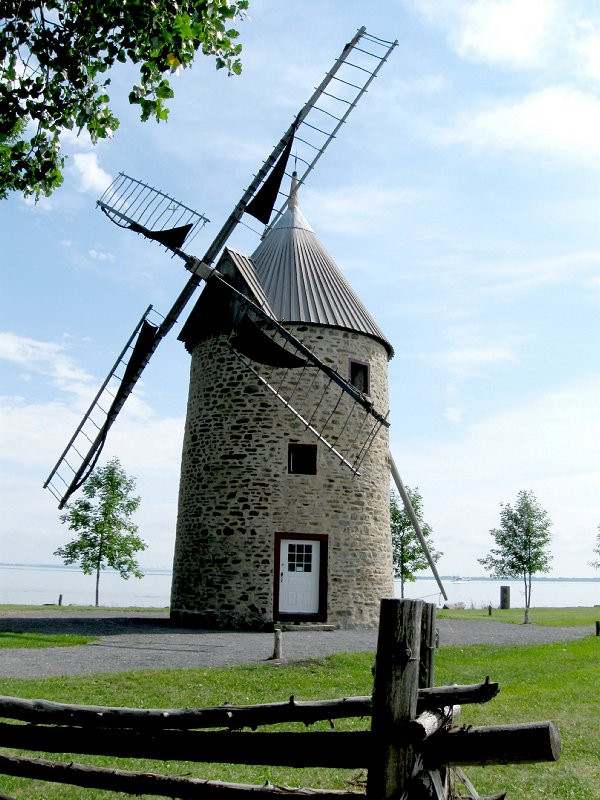HOME | DD
 Lapointe56 — Moulin a vent de l'Ile Perrot
Lapointe56 — Moulin a vent de l'Ile Perrot

Published: 2012-06-29 09:06:59 +0000 UTC; Views: 4148; Favourites: 50; Downloads: 95
Redirect to original
Description
Moulin à vent de l'île Perrot2500, boulevard Don-Quichotte, Notre-Dame-de-l'Ile-Perrot, Québec, J7V 7P2, Canada
(English text following)
Le "Moulin à vent de l'île Perrot", classé Monument Historique, est un moulin à farine construit entre 1705 et 1708. Ce moulin en pierre de forme cylindrique à trois étages est coiffé d'un toit conique pivotant et muni d'une hélice à quatre pales. Il est situé dans la municipalité de Notre-Dame-de-l'Île-Perrot, sur l'île Perrot. Il s'élève sur une pointe de terre, dans la partie sud-est de l'île, au confluent du lac Saint-Louis et de la rivière des Outaouais. Un site archéologique est associé au bien.
La valeur patrimoniale du "Moulin à vent de l'île Perrot" repose sur sa représentativité par rapport à un type de bâtiment industriel, le moulin à farine. Ce moulin est une illustration du moulin-tour, le modèle le plus répandu en Nouvelle-France, par son plan circulaire, ses trois étages, son mur faiblement incliné et son toit conique pivotant sur des lames d'acier graissées au suif (graisse animale). Le premier étage abrite une niche pour la huche à mouture, le foyer de la cheminée dont le conduit est intégré à la paroi et l'échelle du meunier. Le système de réglage de l'écartement des meules et une niche servant de placard occupent le second étage et les meules, le dernier. Tous les mécanismes sont soigneusement reconstitués, permettant d'en comprendre le fonctionnement. Le moulin comprend deux portes en vis-à-vis au premier étage ainsi que deux petites fenêtres carrées, l'une au deuxième et l'autre au dernier étage. Ce moulin est l'oeuvre de Léonard Paillé dit Paillard (1647-1729), un charpentier qui a réalisé plusieurs autres moulins dans les environs de Montréal au XVIIIe siècle, notamment celui de Pointe-Claire, classé bien archéologique.
La valeur patrimoniale du "Moulin à vent de l'île Perrot" repose aussi sur son intérêt historique. Avec la maison du meunier qui s'élève à proximité, il constitue l'un des rares souvenirs tangibles du régime seigneurial à l'île Perrot. Ce moulin est dit « banal », car le régime seigneurial (aboli en 1854) impose aux seigneurs l'obligation de construire un moulin pour leurs censitaires, qui doivent y faire moudre leur grain et payer en retour un droit de mouture, nommé droit de banalité. Le moulin banal occupe une place centrale dans l'économie de la seigneurie.
La valeur patrimoniale du "Moulin à vent de l'île Perrot" repose également sur sa relation avec l'environnement. Il est situé à la rencontre du lac Saint-Louis et de la rivière des Outaouais, sur une pointe de terre bien exposée aux vents. Par son emplacement stratégique, il constitue un repère visuel important. Percé de sept meurtrières, il a servi de redoute, protégeant ainsi l'île Perrot contre d'éventuelles attaques amérindiennes ou britanniques. De plus, d'un point de vue économique, le moulin permettait d'intercepter les arrivages de fourrures en provenance des nations amérindiennes alliées avant qu'ils n'atteignent Montréal. Avec la maison du meunier, également classée monument historique, le moulin forme un ensemble unique au Québec. Le site, transformé en parc historique depuis la fin des années 1970, propose aux visiteurs des activités d'interprétation portant sur diverses facettes de la vie en Nouvelle-France et offre une vue exceptionnelle sur le lac Saint-Louis et Montréal.
Source : Ministère de la Culture et des Communications du Québec, 2004.
Les caractéristiques liées à la valeur architecturale du "Moulin à vent de l'île Perrot" incluent, notamment :
- ses éléments rattachés au moulin-tour, dont le plan circulaire, le mur en moellons de calcaire faiblement incliné, l'élévation de trois étages et le toit conique pivotant sur des lames d'acier;
- ses ouvertures, dont les deux portes d'assemblage vitrées placées en vis-à-vis, les deux fenêtres carrées à quatre carreaux (l'une au deuxième et l'autre au dernier étage) et les sept meurtrières;
- sa cheminée, dont le foyer au premier étage, le conduit intégré à la paroi ainsi que le trou d'évacuation de la fumée dans le haut du mur;
- les deux niches, l'une pour la mouture et l'autre servant de placard.
Les caractéristiques du moulin liées à sa valeur historique incluent, notamment :
- la proximité de la maison du meunier;
- le site archéologique témoignant d'une occupation amérindienne préhistorique et d'une occupation euroquébécoise.
Les caractéristiques du moulin liées à sa relation avec l'environnement incluent, notamment :
- sa situation sur une pointe de terre à la rencontre du lac Saint-Louis et de la rivière des Outaouais;
- la présence de meurtrières.
Google Street View
- Cliquez droit sur le lien et ouvrez dans un nouvel onglet -- [link]
---------------------------------------------------------------------------------
The "Moulin à vent de l'île Perrot", listed as "Monument Historique", is a flour mill built between 1705 and 1708. This stone built mill has cylindrical shape with three floors is wearing a conical roof and equipped with a swiveling four-bladed propeller. It is located in the municipality of Notre-Dame-de-l'Île-Perrot, on Île Perrot. It stands on a headland in the southeastern part of the island at the confluence of Lake St. Louis and the Outaouais River. An archaeological site is associated with the property.
The heritage value of the "Moulin à vent de l'île Perrot" is based on its representativeness compared to a type of industrial building, the flour mill. This mill is an illustration of the mill-turn, the most common model in "Nouvelle-France", by its circular plan, its three floors, its walls and its roof slightly sloping conical rotating steel blades on greased with tallow (animal fat). The first floor houses a niche for the crib to grind, home to the fireplace with the flue is built into the wall and across the miller. The control system of the distance between the wheels and serving as a niche closet occupy the second floor and the wheels, the last. All mechanisms are carefully restored, allowing to understand the operation. The mill comprises two doors vis-à-vis the first floor and two small square windows, the second one and the other on the top floor. This mill is the work of Léonard Paillé dit Paillard (1647-1729), a carpenter who has made several other mills in the neighborhood of Montreal in the eighteenth century, including the Pointe-Claire, ranked archaeological property.
The heritage value of the "Moulin à vent de l'île Perrot" is also based on its historical interest. With the miller's house which stands close by, it is one of the few tangible memories of the seigneurial system in Ile Perrot. This mill is "trivial" because the seigneurial system (abolished in 1854) imposes the obligation lords to build a mill for their tenants who are to have their grain milled back and pay a fee of milling, called right banality. The windmill is central to the economy of the manor.
The heritage value of the "Moulin à vent de l'île Perrot" is also based on his relationship with the environment. It is located at the intersection of Lake St. Louis and the Outaouais River, on a point of land well exposed to winds. Its strategic location, it is an important visual cue. Were drilled loopholes, he served as a redoubt, thus protecting the island against attack Perrot by Indian or British. In addition, an economic perspective, allowing the mill to intercept shipments of furs from the Amerindian allies before they reach Montreal. With the miller's house, also a historical monument, the mill forms a unique set in Quebec. The site turned into a historic park since the late 1970s, provides visitors with interpretive activities on various facets of life in "Nouvelle-France" and offers an exceptional view of Lake St. Louis and Montreal.
Source : Ministère de la Culture et des Communications of Quebec, 2004.
Characteristics related to the architectural value of the "Moulin à vent de l'île Perrot" include, among others:
- Its elements attached to the mill-turn, which is circular, the wall built of limestone slightly sloping, rising three floors and the roof conical pivoting on steel blades;
- Any openings, two glass door assembly placed vis-à-vis the two square windows of four panes (one second and one on the top floor) and the seven deadly;
- Fireplace, whose focus on the first floor, duct built into the wall and the drain of smoke in the top of the wall;
- The two niches, one for milling and the other serving closet.
Characteristics related to the mill include its historical value, including:
- The proximity of the miller's house;
- The archaeological evidence of a prehistoric Native American occupation and an occupation euro-quebecoise.
The characteristics of the mill linked to its relationship with the environment include, among others:
- Its location on a point of land to meet the Lake St. Louis and the Outaouais River;
- The presence of loopholes.
Google Street View
- Right click on the link and open in a new tab -- [link]
Related content
Comments: 14

May I use this for a school assignment?
I just have to sketch the image, we are learning point perspective, it will only be used for a grade, nothing more.
👍: 0 ⏩: 0

Très jolie photo
....Tu sais probablement qu'il y a deux portes à un tel moulin pour offrir au meunier deux sorties pour éviter de ce faire raccourcir d'une tête...c'est l'origine de l'expression Moulin Rouge...un moulin qui avait tué son opérateur...
👍: 0 ⏩: 1

You took a wonderful picture of the Windmill. I like Windmills as much as Lighthouses, there is just something about how the buildings served the world. In Holland Michigan they have a working Windmill that still grinds wheat into flour.
Dygyt Alice
Thank you for sending me the reading material. I have not had a chance to read very much of it and I hate read a little at a time. I will make time to read and enjoy every minute.
👍: 0 ⏩: 1

We also, in Saint-Eustache a mill which is still flour by hand. You just make me remember that I'm not going to see for three years ...
The lighthouses, I had many pictures of when traveling in the Gaspésie and in the New-England, but they are 35mm, I would have to find them and I scan it ... I have so much to do with digital photos, and that are better quality than a scan ...
How is your mother, I hope she laughed her six times today
👍: 0 ⏩: 1

Yes she said to me if I talked to you and say we had our six laughs before she got out of bed. Thank you for asking she saw her new Doctor yesterday. Keep you fingers crossed and thank you once again for something to read.
Dygyt Alice
👍: 0 ⏩: 1

I'm crossing everything I can so it can be useful ... I send to her "beaucoup d'amour" ...
👍: 0 ⏩: 1

Mom has sent you lots of love back even though it sounds better in French. We keep you in our thoughts and wish you luck and love. Thank you for all your help.
Dygyt Alice
👍: 0 ⏩: 1

It's been a pleasure and it sounds good in all languages ... 
It is thanks dA that we met, perhaps in the street we would not even talk ... who knows?
You informed me about your mom, but in the "Notes" That does not have to be public ...
👍: 0 ⏩: 1

Not a problem we can send notes about my family. Not everyone needs to know.
Dygyt Alice
👍: 0 ⏩: 1

Merci, c'était facile, le modèle ne bougeait pas
👍: 0 ⏩: 1





























